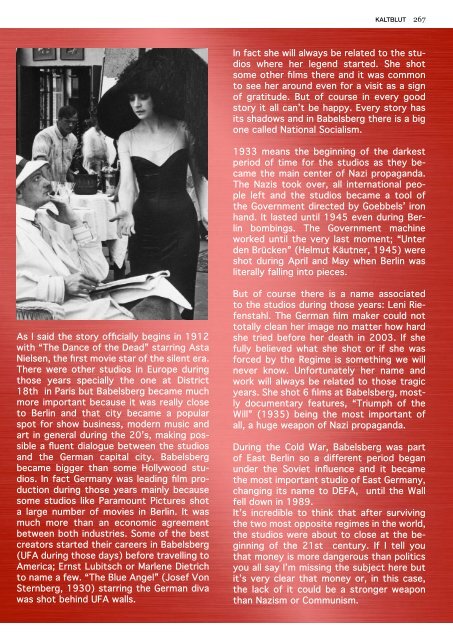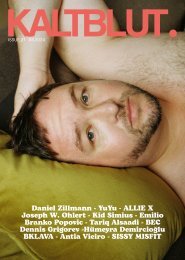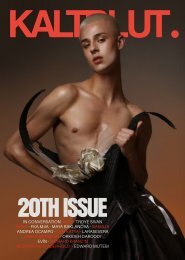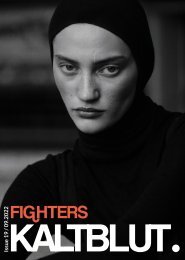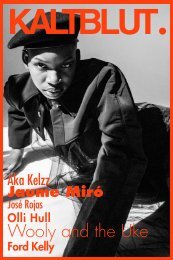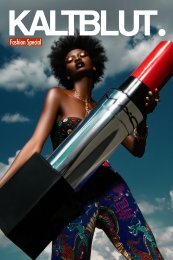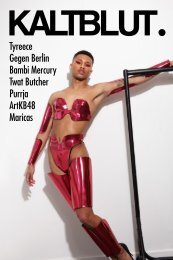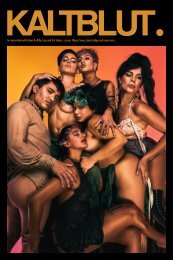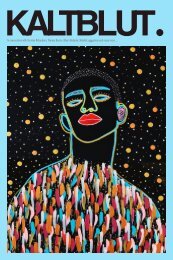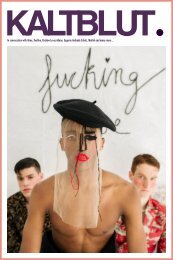COLLECTION 2 - AVANT-GARDE
The Avant-Garde. Hello, welcome to our second KALTBLUT Collection. www.kaltblut-magazine.com 400 pages of the theme Avant-Garde. www.kaltblut-magazine.com Featuring artists like: Adam Green, Tata Christiane, Slava Mogutin, SELLAH, Kristian Jalonen, Kali, Emilie Simon, Tobias Jundt, Remedios Varo, Marc Johns, Reka Koti, Kelly De Block, Berglind Agustsdottir, Andrew Huan, Emma Elina Keira Jones, Amanda Morgan Jansson, Susu Laroche, Jeroen Mylle and many more. Published by Marcel Schlutt
The Avant-Garde. Hello, welcome to our second KALTBLUT Collection. www.kaltblut-magazine.com 400 pages of the theme Avant-Garde. www.kaltblut-magazine.com Featuring artists like: Adam Green, Tata Christiane, Slava Mogutin, SELLAH, Kristian Jalonen, Kali, Emilie Simon, Tobias Jundt, Remedios Varo, Marc Johns, Reka Koti, Kelly De Block, Berglind Agustsdottir, Andrew Huan, Emma Elina Keira Jones, Amanda Morgan Jansson, Susu Laroche, Jeroen Mylle and many more. Published by Marcel Schlutt
You also want an ePaper? Increase the reach of your titles
YUMPU automatically turns print PDFs into web optimized ePapers that Google loves.
As I said the story officially begins in 1912<br />
with “The Dance of the Dead” starring Asta<br />
Nielsen, the first movie star of the silent era.<br />
There were other studios in Europe during<br />
those years specially the one at District<br />
18th in Paris but Babelsberg became much<br />
more important because it was really close<br />
to Berlin and that city became a popular<br />
spot for show business, modern music and<br />
art in general during the 20’s, making possible<br />
a fluent dialogue between the studios<br />
and the German capital city. Babelsberg<br />
became bigger than some Hollywood studios.<br />
In fact Germany was leading film production<br />
during those years mainly because<br />
some studios like Paramount Pictures shot<br />
a large number of movies in Berlin. It was<br />
much more than an economic agreement<br />
between both industries. Some of the best<br />
creators started their careers in Babelsberg<br />
(UFA during those days) before travelling to<br />
America; Ernst Lubitsch or Marlene Dietrich<br />
to name a few. “The Blue Angel” (Josef Von<br />
Sternberg, 1930) starring the German diva<br />
was shot behind UFA walls.<br />
KALTBLUT<br />
267<br />
In fact she will always be related to the studios<br />
where her legend started. She shot<br />
some other films there and it was common<br />
to see her around even for a visit as a sign<br />
of gratitude. But of course in every good<br />
story it all can’t be happy. Every story has<br />
its shadows and in Babelsberg there is a big<br />
one called National Socialism.<br />
1933 means the beginning of the darkest<br />
period of time for the studios as they became<br />
the main center of Nazi propaganda.<br />
The Nazis took over, all international people<br />
left and the studios became a tool of<br />
the Government directed by Goebbels’ iron<br />
hand. It lasted until 1945 even during Berlin<br />
bombings. The Government machine<br />
worked until the very last moment; “Unter<br />
den Brücken” (Helmut Käutner, 1945) were<br />
shot during April and May when Berlin was<br />
literally falling into pieces.<br />
But of course there is a name associated<br />
to the studios during those years: Leni Riefenstahl.<br />
The German film maker could not<br />
totally clean her image no matter how hard<br />
she tried before her death in 2003. If she<br />
fully believed what she shot or if she was<br />
forced by the Regime is something we will<br />
never know. Unfortunately her name and<br />
work will always be related to those tragic<br />
years. She shot 6 films at Babelsberg, mostly<br />
documentary features, “Triumph of the<br />
Will” (1935) being the most important of<br />
all, a huge weapon of Nazi propaganda.<br />
During the Cold War, Babelsberg was part<br />
of East Berlin so a different period began<br />
under the Soviet influence and it became<br />
the most important studio of East Germany,<br />
changing its name to DEFA, until the Wall<br />
fell down in 1989.<br />
It’s incredible to think that after surviving<br />
the two most opposite regimes in the world,<br />
the studios were about to close at the beginning<br />
of the 21st century. If I tell you<br />
that money is more dangerous than politics<br />
you all say I’m missing the subject here but<br />
it’s very clear that money or, in this case,<br />
the lack of it could be a stronger weapon<br />
than Nazism or Communism.


